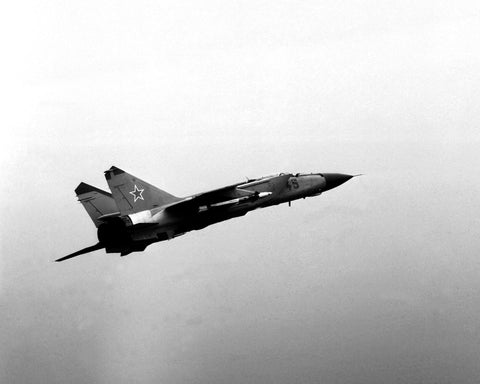
Inside the MiG-25, a Supersonic Fighter Second to All

The Mikoyan-Gurevich MiG-25 was a product—and victim—of the brief vogue of supersonic nuclear bombers, specifically the Mach 3 North American XB-70 Valkyrie. Work began on the MiG-25 in mid-1959 and it made its debut flight, with a reconnaissance variant, the Ye-155-R1, on March 6, 1964. The interceptor prototype, Ye-155-P1, first flew on September 9, 1964. By then the intercontinental ballistic missile had redefined the Cold War “balance of terror” and the XB-70 had been scrapped, but the emergence of the Lockheed A-12 (and later SR-71 Blackbird) Mach 3 reconnaissance planes gave the MiG something to intercept. Upon its first public appearance in July 1967, the MiG-25 set 29 speed, altitude and time-to-climb records, some of which still stand. In 1976, however, when Soviet pilot Viktor Belenko defected to Japan, his MiG-25 “Foxbat” (as the North Atlantic Treaty Organization codenamed it) revealed an overweight mass of stainless steel, since the Russians lacked the cutting tools and experience to work with the titanium that made the SR-71 so much more successful.
The MiG design bureau remained committed to produce a total of 1,190 Foxbats, and the airplane’s speed made them quite useful high-speed reconnaissance planes, even if they remained second in performance to their Blackbird rivals. They were also used in electronic intelligence, training and bombing. Although the study of Belenko’s plane devalued the MiG-25s, it did earn them international sales among the air arms of Libya, Syria, Algeria, Iraq and India. They saw combat over the Middle East, especially in the 1980s, when Iraqi aircraft dueled those of Iran. Most uncharacteristically, on January 17, 1991, it was a MiG-25 flown by Lieutenant Zuhair Dawood of No.84 Squadron, Iraqi air force, that shot down an F/A-18 Hornet of fighter-attack squadron VFA-81 “Sunliners” off the aircraft carrier USS Saratoga. Its pilot, Lieutenant Commander Michael Scott Speicher, was the first American killed in action during Operation Desert Storm.
MiG-25P Specifications:
Crew: 1
Wingspan: 46 feet
Wing area: 661 square feet
Length: 78 feet 2 inches
Height: 20 feet
Empty weight: 44,092 lb.
Fully loaded weight: 80,954 lb.
Engines: 2 Tumansky R-15B-300 afterburning turbo jets, 16,500 lbf. thrust each dry, 22,500 lbf. on afterburner
Operational maximum speed: Mach 2.83
Climb rate: 40,900 ft. per min.
Service ceiling: 67,900 ft. with four missiles
Range: 1,160 miles at Mach 0.9; 1,013 miles at Mach 2.35
Armament: 4 R-40R/T air to air missiles (NATO code designation AA-6 Acrid)
this article first appeared in AVIATION HISTORY magazine
Facebook @AviationHistory | Twitter @AviationHistMag
